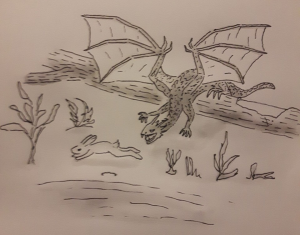Difference between revisions of "Drake"
From World of Entorais Wiki
Jump to navigationJump to search (→Ecology: content) |
(→Description: content) |
||
| Line 8: | Line 8: | ||
;Size: 68 kg (150 pounds), 2 m ( 6 feet, 7 inches) length nose to tail, 2.5 m (9 feet, 4 inches) wing span | ;Size: 68 kg (150 pounds), 2 m ( 6 feet, 7 inches) length nose to tail, 2.5 m (9 feet, 4 inches) wing span | ||
;Appearance:The appearance of these creature matches the much larger dragons of myth and legend. They are quadrupeds with a pair of large wings capable of powered and gliding flight. Long necks and tails make up a significant portion of their body length. their heads are typically adorned with horny frills, and a maw of sharp teeth. Their bodies are covered in tough scaled hides. | ;Appearance:The appearance of these creature matches the much larger dragons of myth and legend. They are quadrupeds with a pair of large wings capable of powered and gliding flight. Long necks and tails make up a significant portion of their body length. their heads are typically adorned with horny frills, and a maw of sharp teeth. Their bodies are covered in tough scaled hides. | ||
;Sexual dimorphism:Males and females do not show significant differences in size or body form. In some sub-species, the males | ;Sexual dimorphism:Males and females do not show significant differences in size or body form. In some sub-species, the males have brighter colouration and more elaborate patterning than females. | ||
;Variance:Sub-species exist, with minor variance in body form, colouration, habitats, and behaviours. | ;Variance:Sub-species exist, with minor variance in body form, colouration, habitats, and behaviours. | ||
Revision as of 17:30, 21 June 2021
About
- These small creatures resemble dragons in form, and may be a related, however they lack the ability to breathe fire, and as such are not considered true dragons.
- Common Names
- Drakes
Description
- Classification
- Reptile
- Size
- 68 kg (150 pounds), 2 m ( 6 feet, 7 inches) length nose to tail, 2.5 m (9 feet, 4 inches) wing span
- Appearance
- The appearance of these creature matches the much larger dragons of myth and legend. They are quadrupeds with a pair of large wings capable of powered and gliding flight. Long necks and tails make up a significant portion of their body length. their heads are typically adorned with horny frills, and a maw of sharp teeth. Their bodies are covered in tough scaled hides.
- Sexual dimorphism
- Males and females do not show significant differences in size or body form. In some sub-species, the males have brighter colouration and more elaborate patterning than females.
- Variance
- Sub-species exist, with minor variance in body form, colouration, habitats, and behaviours.
Ecology
- Habitat
- Drakes are found in all terrain types form Tropical to Sub-Arctic latitudes.
- Diet
- Omnivores with a large meat portion to their diet.
Behaviour
- Social grouping
- Temperament
- Drakes tend to by wary of larger animals and people. They will avoid direct conflict with anything larger than themselves unless cornered, or defending their nest. They are territorial towards other drakes.
- Intelligence
- Drakes possess a cunning animal intellect. They are capable of planning and can avoid or escape many traps set to capture them.
- Reproduction
- Drakes will form mated pair-bonds and establish an elevated nest with a associated hunting range. The female will lay a clutch of four to six eggs, which the adults then take turns brooding until they hatch. Both parents will take turns providing food for the hatchlings until they are developed enough to take flight on their own, and regularly hunt for themselves, at which point the young will be driven from the pair's territory.
- Hunting
- Drakes tend be solitary hunters of small animals, birds and fish. Mated pairs will hunt in turns while providing for young in their care. They tend to attack prey from a elevated position, swooping down on wings to grab with teeth and claws. Prey will be carried away to their nesting area for consumption.
- Scavenging
- Drakes will feed from larger carcasses, but unlikely to hunt and kill anything which they cannot carry away.
Sub-Species
- A range of sub-species exist varied mostly in habitat and colouration. Morphological differences between sub-species exist.
Domestication
- General
- Efforts to domesticate drakes generally fail due to the aggressive feral nature of these beasts. Some hunters have managed to train them to assist with tracking and flushing small game.
- Resources
- Meat
